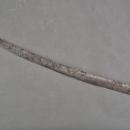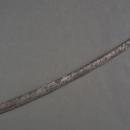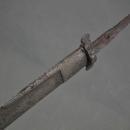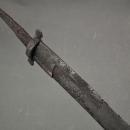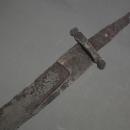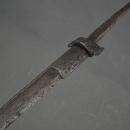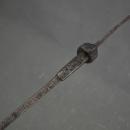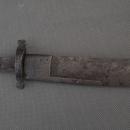Antique Medieval Sword 9th -11 Century A.D. Turkic Khazar Islamic Al-Arsiya Sabre








$4,000.00
Or Best OfferRare antique medieval sword-saber from the 9th -11 century AD, Turkic Khazar or the al-Arsiya military corps.
The Khazars were nomadic Turkic people best known for converting to Judaism in the 8th and 9th centuries. Their rule lasted at least 250 years, supported militarily by Muslim mercenaries known as al-Arsiyah.
The sword has an exceptionally well-forged, slightly curved blade, with a flat upper spine, the sturdy blade has a false edge (Yelmen) tapering towards the tip.
The blade's tang is mounted with a short crossguard with flattened quillons and is pierced with two holes for rivets to attach wooden grip scales.
Ricasso is encased in a shaped collar that helps secure the guard and ensures a tight fit in the scabbard.
Since the blade is heavy, thick, sharp, and well-profiled, this sword in the hand of a warrior was a powerful and deadly weapon that could easily cut an iron helmet.
In the time of the Tang Dynasty, during their contact with Turkic steppe nomads, the Chinese adopted curved sabers with this type of collar, known in Chinese as (tūnkǒu tūnkǒ), and then the Japanese took them from the Chinese and called these collars "Habaki."
This is the best quality of this type of saber that I have seen in my over 50 years of experience with antique swords.
This particular sword is better quality than the average type; it is also larger, much heavier, and has a thicker spine.
The blade is sturdy, heavy, and not bent, indicating that this sword is made of high carbonate steel, possibly welled Damascus steel.
Also, the blade is in good condition compared to other such swords, most of which are in a very rusty excavated condition.
This rare type of saber belongs to the group of the earliest sabers, which were invented by Turkic nomads of various tribes (including Khazars and Seljuk or Seljuq Turks) inhabiting a large area in the 8th-11th centuries ranging from the Chinese border across Central Asia to Eastern Europe and the Middle East.
This type of Turkic saber was used by Muslim warriors from the Al-Arsiyah military corps in the Khazar army, whose troops were recruited from Turkic Muslims from Khawārizm (خَـوَارِزْم) and also by the Samanid, Ghaznavid, and Seljuq cavalry and other nomadic Turkic tribes of the Euro Asian steppe.
A most famous sword related to the so-called Khazar sabers is the famous "Charlemagne Sabre," one of the oldest sabers from the western steppe preserved in Europe.
Once considered a gift from Harun al-Rashid to Charlemagne, it is now believed that Eric of Friuli brought it in 796 AD.
The sword is housed in the Schatzkammer of the Hofburg Palace in Vienna (see Berlin 1989, p.531, cat.3/3, fig. 622).
REFERENCES:
1. "The Art of the Muslim Knights: The Furusyya Art Foundation" Page 33 Number 4, Page 34 Number 5, Page 35 Number 6, Page 39 Number 9.
2. The related sword was sold at Christie's, London, on 10 October 2000, lot 225. Please see the link below:
https://www.christies.com/lot/lot-1879589?ldp_breadcrumb=back&intObjectID=1879589&from=salessummary&lid=1
3. A similar sword was sold at Sotheby's, London, on 27 October 2007, lot 225. Please see the link below:
https://www.sothebys.com/en/auctions/ecatalogue/20...
3Two other related examples were sold in London at Sotheby's on 24 October 2007. Please see the links below:
http://www.sothebys.com/en/auctions/ecatalogue/2007/arts-of-the-islamic-world-including-fine-carpets-and-textiles-l07222/lot.226.html
The buyer will be provided with a copy of the pages from the mentioned references, together with a certificate of authenticity.
CONDITION:
It is in very good condition for an antique steel combat sword that is over 1000 years old. The surface is slightly corroded.
MEASUREMENTS:
Overall length: 104 cm (40.94 inches).
Width of the blade at the widest point: 3.2 cm (1.26 inches).
The thickness of the ricasso collar: 10 mm.
The thickness of the blade spine: 7 mm.
WEIGHT: 9.4 kg (20 pounds).
PROVENANCE: From the old Canadian collection of Islamic art, which also included Islamic arms and armor.
Link to Khazars History:
https://www.britannica.com/topic/Khazar
